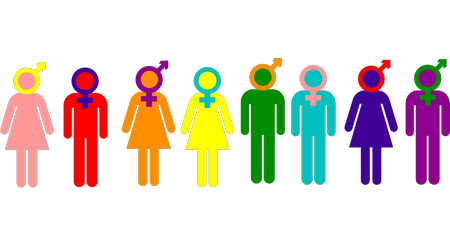The classic definition of gender is no longer considered a correct definition in our day. In the past, the word was used technically to differentiate between men and women. In this it was a synonym to the word sex. However, in the English language the word sex began to have an erotic connotation, thus it became common to use the word gender in polite discourse. For example, a form would request the information:
Gender: ___ Male ___ Female
No longer is this the case. Now, the common definition of the word is: “either of the two sexes (male and female), especially when considered with reference to social and cultural differences rather than biological ones. The term is also used more broadly to denote a range of identities that do not correspond to established ideas of male and female.
The meaning of the word has changed because the usage of the word in common discourse changed. This is the way language works. Words can go so far as to become the exact opposite of what they once meant, because of usage.
Because of this change, when most people refer to gender today, they refer to a person’s self-identity. The common expression is gender identity, and with that redefinition, the idea of normalcy is no longer relevant. This is why in our society, a multitude of “genders” have been “self-identified.” In effect, if I look at myself in this way, this way is my normal.
The term “gender dysphoria” has been used to describe a sense of unease that a person may have because of a mismatch between their biological sex and their gender identity. It was once an accepted medical term, and those who were diagnosed with it (due to the accompanying depression, anxiety and other mental issues) were often given therapy to help with the issue. Now, usage of the term is problematic to many. Where once an effort was made to counsel to relieve mental struggles, today the approach is physical, to change the body to match the mind. Consider this from the Mayo Clinic: “Medical treatment of gender dysphoria might include: Hormone therapy, such as feminizing hormone therapy or masculinizing hormone therapy. Surgery, such as feminizing surgery or masculinizing surgery to change the breasts or chest, external genitalia, internal genitalia, facial features, and body contouring.”
In other words, we once treated the reality, trying to get people to get comfortable with their biology. Now, the common treatment is to superficially change the look of the body to mask the reality. Though surgeries are done, and hormones are taken, and society calls people by their new name and “gender”, there has been no biological change at all. You are what you were born as, from birth to death.
How does the Bible treat the question of gender? Well, as the term is today, it doesn’t refer to it at all. The Bible refers only to men and women, so the Biblical view of gender is binary. “So God created man in His own image; in the image of God He created him; male and female He created them” (Genesis 1:27). While we acknowledge that there are biological exceptions (hermaphrodites, for example), these are rare, unfortunate and abnormal. The Genesis account refers to what is normal, or physically in accord with nature.
So, when the Bible talks of homosexuality, bisexuality, transgenderism, et al., it speaks of it as unnatural. As Paul said, homosexuality is “against nature” (Romans 1:26-27). Because it is unnatural, the prohibitions against it found in the Old Testament declare it to be an abomination to God. “You shall not lie with a male as with a woman. It is an abomination” (Leviticus 18:22).
The word abomination is seldom used in the Old Testament. It means, “something morally disgusting, abhorrent.” It is typically used regarding four things. The first is the eating of unclean meat (cf. Leviticus 11). God said that such animals were an abomination to the Israelites. Later, Jesus eased such dietary restrictions (as noted in Acts 10:10-16). Second was the practice of idolatry, which is stated time and again as an abomination to God, (cf. Deuteronomy 7:25). This is an abomination because it is sin. A third area where God considers acts as abominations centers on things like dishonesty, lying, stealing and cheating. And then finally, God considers sexual sin, including homosexuality, and intentional efforts to blur gender, as abominable, (cf. Leviticus 18:22,23; 20:13; Deuteronomy 24:4).
Consider these words from Moses’ law: “A woman shall not wear anything that pertains to a man, nor shall a man put on a woman’s garment, for all who do so are an abomination to the Lord your God” (Deuteronomy 22:5). Compare them to Paul’s words in 1 Corinthians 11:14-15, “Does not even nature itself teach you that if a man has long hair, it is a dishonor to him? But if a woman has long hair, it is a glory to her; for her hair is given to her for a covering.”
An honest examination of scripture reveals that God made men and women, and intend for them to be men and women. This distinction is defined in marriage (cf. Genesis 2:24), with the realization that a woman, with her physical differences is a suitable companion for a man. It is why homosexuality and other forms of fornication are condemned in scripture (cf. Hebrews 13:4). And, it is why our culture’s concerted effort to blur the differences between a man and a woman are against nature, and an abomination to God.





